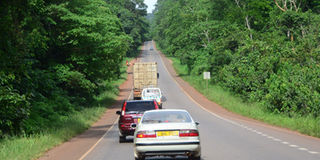ON THE ROAD: Understanding black spots

Mabira black spot along Jinja Road. When you are not conversant with a particular road, slow down and drive with caution. Photo by Michael Kakumirizi
What you need to know:
When an accident first happens on a road, it can be taken just as an accident but when it happens more than once at the same spot, then something has to be done. Accident-prone areas have been identified as black spots. But how can you drive through them to avoid accidents?
Approximately four weeks ago as Charles Ofwono was driving to Jinja, he met a trailer that had overturned in Mabira forest few inches off the road. It had hit a tree. On the opposite side of the road was a saloon car whose driver’s side had been severely scratched. The bonnet area was facing the forest as its boot and rear tyres remained hanging.
“I heard a loud bang from the forest and I thought a tree had fallen. When I drove on for a few metres, I realised that it was an accident involving a trailer and a saloon car. It had just happened because the tyres of the trailer were still rolling. It had rolled over,” Ofwono recalls.
Charles Ssebambulidde, the traffic directorate spokesperson, says Mabira forest, in its entirety, irrespective of where you are driving from, is a black spot.
Causes
Black spots, which are also sometimes called dark spots, are places where more than three accidents have occurred. Black spots may be blind corners or very long and narrow stretches. They may also be steep hills that when you are overtaking, it is hard, if not impossible for you to see vehicles from the oncoming traffic. Black spots may even be at junctions.
For example, when you are driving to Masaka, you may find a junction to Mpigi with several motorists coming from the same side.
Ssebambulidde observes that motorists who become victims of accidents at black spots are mainly those who are not conversant with a particular road and are fond of overtaking anyhow.
“If you overtake within Mabira forest and it is raining or at night, chances are you will ram into an oncoming truck or one that has a mechanical problem and is parked by the roadside,” Ssebambulidde says.
It is also important to note that some vehicles have headlights that do not function well or are too dim. There are also vehicles that have one functioning headlight that it can be mistaken for a motorcycle, yet it is a car. So, you need to be careful and observant on the road before overtaking to avoid head-on collisions.
Preventive mechanisms
When under construction, roads are marked with signs such as those that warn you about swamps, sharp corners and junctions.
Whenever you drive, especially along highways, Ssebambulidde warns that you must be very careful and monitor road signs. At the same time, do not drive fast when you are on the road for the first time because you can never know what is ahead of you.
Dr Steven Kasiima, the director of Traffic and Road Safety Directorate, argues that some places have come to be known as black spots as a result of narrow roads.
“Most of the roads we have are narrow in nature. If we had dual carriage roads with two lanes on each side of the road, there would be no head-on collisions. Motorists would find a way of negotiating on the road to prevent head-on collisions,” Kasiima explains.
Dual carriage roads are the type of roads that have two lanes on each side of the road. Dual carriage roads such as the Entebbe Expressway are constructed with capacity of carrying two lines of vehicles both on the oncoming and outgoing traffic.
Prepare for the unexpected
Ssebambulidde advises that every time you are driving, be careful and cautious of the unexpected. Cases in point are black spots which are prone to accidents. You will sometimes find broken down vehicles because of the nature of the area. The vehicle could be there after it probably failed to negotiate a corner, when the road was steep and the vehicle, especially loaded trailers failed to go up the hill or when the vehicle drifted when going down the hill.
“Whenever you are driving and you approach these places, think of any obstacles such as broken down vehicles or people crossing. You must always be cautious to avoid accidents. Do not only think that since it is a corner, you can drive anyhow. You never know there could be a motorist who failed to negotiate the same corner. That is why you find one accident involving a series of vehicles just because motorists are not conscious of where they are going,” Ssebambulidde concludes.
Common black spots
Masaka road
Some of the black spots on Masaka Road include Mitala Maria junction, Mbizinya, Kalandazi, Buwama, Nabusanke at the centre, Nabyewanga, Mukoko, Kabale-Bugonzi, popularly known as Basudde corner, Kaddugala and Kibukuta at the junction after the swamp.
Jinja Road
Those onJinja Road include Kitega, the whole of Mabira forest, Kitigoma, Bulyantete, Mbiko, Nyenga, Namagunga and Kalandazi, among others.Some of the black spots along Bombo Road include Kakerenge, Sinalya, Kibisi-Wobulenzi, Kikoma, Kiwumpa, Nakazi, Kyevunze, Ndibulungi, Ngaju, Kakinzi and Nalongo, among others.
Mityana Road
On Mityana Road, look out for Gyeza, Kiwawu, Ttamu, Ndibulungi, Wabigalo, Buswabulongo, Busimbi junction, Kikumbi, Naama and Mpamujjugu swamp, among others.
Hoima Road
Some of the black spots on Hoima Road include Kizigo after Kikandwa, Matte at the T-junction, Wangoma, Namigavu, Kanyale, Bukalammuli, Kikunyu, Sekanyonyi, Mayanja River, Wamika, towards Kiboga. From Busunju to Kampala, black spots include Kyanuma, Namayumba, Mwera, Kikandwa-Kakiri, Ggobero and Nakyerongoose, among others.




